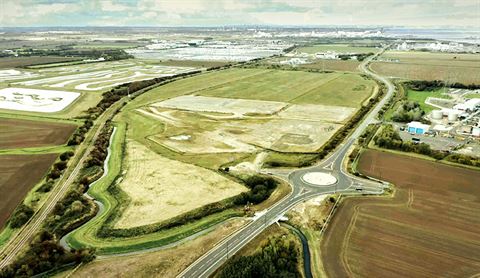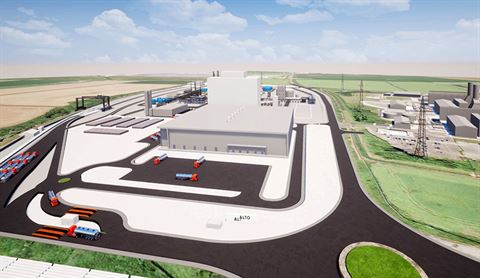FUTURE OF FLIGHT • January 2021
Sustainable jet fuel from trash gets one step closer
Imagine if household waste could power jet planes instead of being sent to landfill. Aero-industry journalist Paul Sillers reports on an innovative initiative designed to bring sustainable aviation fuel to market
As air travel tentatively gears up for a reboot, sustainability is high on the agenda. But to turn carbon-neutral aviation from a slogan into a tangible reality, the full spectrum of innovative aerospace technologies has to be leveraged. Electric airplanes and hydrogen-powered aircraft will play major roles in the decarbonisation of flight – especially for short-haul trips. However, these could take a decade or so to mature and scale to a level that makes commercial sense for airlines to operate.
Meanwhile, other sustainable flight paths are within closer reach. Some are already being implemented, such as sustainable aviation fuel (SAF), for example, which uses renewable ‘feedstocks’ (the raw materials from which SAF is derived). Feedstocks come from a variety of sources, such as agricultural waste, wood residue deposits and wood debris lying on forest floors. The good news is that SAF can also be made from such unlikely things as non-recyclable coffee cups, disposable nappies and used cooking oil – the unwanted detritus of modern life. Instead of it ending up in landfill, it could be the stuff that powers air travel in the near-term future.
BA’s sustainability commitment
A compelling example of this is an initiative currently under way under a joint development agreement between British Airways and sustainable fuels technology company Velocys to manufacture jet fuel from household and office waste at the Altalto facility in North East Lincolnshire (pictured below). The airline’s backing demonstrates BA parent company IAG’s commitment to investing $400m in alternative sustainable fuel development over the next 20 years.
The initiative will reduce greenhouse gas emissions by 70 per cent for every tonne of sustainable jet fuel that replaces a tonne of conventional fossil fuel and, once up and running by the mid-2020s, the Altalto plant could produce enough fuel for more than 1,000 London to New York flights each year using SAF in an A350 aircraft.

How the waste-to-fuel process works
“We’re starting with municipal solid waste, commercial and industrial wastes, as well as ‘black bag waste’ from individual households – the stuff that isn't destined for recycling,” says Neville Hargreaves, VP Waste to Fuel, Velocys. “Contaminated waste such as a fish and chip wrapper has negative economic value, but it does have energy content. Typically, it’s sent to landfill or incinerated to recover some energy from it. But that’s a very inefficient process.”
Velocys’s plan is to take that waste, shred it, sort it, dry it, remove metals and glass (which can be recycled) then apply a chemical process to that dried, shredded waste. “There are many steps, but in very simple terms we’re breaking down the waste to release the carbon and hydrogen – we break it down so it comes out as a gas, then we put that gas through our own Velocys technology, which is a reactor and catalyst, and that builds it back up again in the form of SAF,” says Hargreaves.
The result? Clean fuel. Velocys’s process removes all the contaminants that are found in ordinary jet fuel, thereby reducing particulate emissions by up to 90 per cent and eliminating any sulphur in the exhaust trail from the airplane when SAF is combusted in the aircraft’s engines. This brings air quality benefits as well as the low carbon benefits.
The blueprint for the UK’s post-pandemic future focuses on climate change targets
Supporting a green recovery
What could also spur the uptake of SAF is commitment at a political level, especially as air travel starts to ramp up in the wake of Covid-19 vaccine developments. In November, the UK Government published a ‘Ten Point Plan for a Green Industrial Revolution’, covering clean energy, transport, nature and innovative technologies, which will create and support up to 250,000 British jobs.
This blueprint for the UK’s post-pandemic future focuses on climate change targets – particularly crucial in the run-up to the COP26 climate summit in Glasgow in November 2021. The commitment involves “taking immediate steps to drive the uptake of sustainable aviation fuels, investments in R&D to develop zero-emission aircraft and developing the infrastructure of the future at our airports.”
Additionally, the Government will run a £15m competition to support the production of SAF in the UK and also establish a SAF clearing house, the first of its kind in Europe, to enable the UK to certify new fuels.
But what will it cost?
Hargreaves says SAF costs more than ordinary jet fuel to make because a substantial transformation is involved, whereas the latter is just distilled from crude oil. “That cost gap needs to be bridged. In the UK, that’s provided by the Renewable Transport Fuels Obligation – a government mechanism that helps bridge that gap, so that it doesn’t all fall on the airline.”
Replacing today’s jet fuels with SAF
Looking at the broader global aviation picture, according to a recent report published by the World Economic Forum based on analysis by McKinsey & Company, there’s enough sustainable feedstock, such as municipal waste, agricultural residues and cooking oil waste, to fulfil the anticipated jet-fuel demand of all commercial aviation by 2030.
But here’s the thing. In 2019, less than 200,000 metric tonnes of SAF were produced globally – a tiny fraction of the 300 million tonnes of jet fuel used by commercial airlines. So, despite the potential fulfilment of aviation’s fuel needs using SAF by the end of this decade, the reality is that planned production capacity investments will only yield just one per cent of global jet fuel demand for 2030.
“We see the classic Catch-22 problem as in other energy transition discussions. Insufficient scale drives per unit costs high and high costs keep demand low,” says Daniel Riefer, associate partner, McKinsey & Company. “Some structural solutions could break this impasse – B2B contracts, prioritised aviation and airport fee structures etc – that will give fuel producers the required support to invest in production capacity.”

Europe’s first municipal waste-to-jet fuel facility
This is where mandates come in. Norway has a mandate, Sweden and Finland are introducing mandates, and the UK government is looking at SAF mandates to come in by 2025 as part of its Ten Point Plan. “Mandates will help spread the cost, so the airlines that take the initiative to invest in SAF won’t be penalised,” says Hargreaves. But, longer term, fossil-based aviation fuel will rise, and he adds that, “As the price of carbon goes up, and the cost of SAF comes down, the price(s) of jet fuel and SAF will equalise – but it’s a long process to reach that equalisation point.”
How the Velocys project is shaping up
A key milestone was reached in June 2020 when a formal notice of the decision to grant planning permission for the Altalto Immingham plant (pictured above) was issued by North East Lincolnshire Council – a key step for any project involving waste. Velocys reports that feedback from the local community has been positive, with the realisation that the initiative is bringing green, sustainable jobs to an area that needs them.
The project requires additional financing, which needs Government policies to enable such first-of-a-kind plants to attract investment. Fortunately, it’s clear that SAF is now recognised as critical to the future of aviation. “Waste as a feedstock isn’t going to go away,” says Hargreaves. “In the long term, I hope we’ll all move towards our waste being biogenic, where we’ll use bio plastics rather than fossil plastics. But we’ll still have stuff that can’t easily be recycled, or is uneconomic to separate out – so there will still be waste, and it’ll still be a cheap feedstock for making SAF.”
For now, the key objective is to get the first few SAF projects into the market, says Hargreaves: “We are in the vanguard – Velocys will probably be the first waste-to-jet fuel plant in Europe. And, if we can do that, further investments in SAF will flow in.”
This article has been tagged BA, Technology
More from previous issues

Five epic drives: António Félix da Costa
Formula E Champion and Portugal’s star racer tells us about the road trips that left him wanting more

A toast to the travels of Christmas past
We’ve rounded up some trusty pilots and recognisable faces to take us on a merry walk down memory lane

Inside London’s most Christmassy hotels
Not feeling the festivities quite yet? Let our hotel insiders help you along with a glimpse inside their storied doors

The battle of the Christmas movies
Two of best film critics in the biz, two totally different festive flicks. Let the credits roll....
